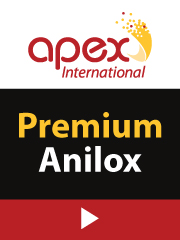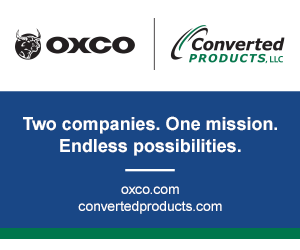New Roles for Converters
- Published: October 01, 2009, By By Edward D. Cohen, Consulting Inc.
The process technology now in routine use in the converting industry will perform a key role in the commercialization of several advanced, high-technology product concepts currently under development. Among them are fuel cells, solar cells, thermal solar reflectors, advanced electronic systems, RFID chips, security systems, and medical devices. An essential requirement for the successful development and implementation of these products is a commercially effective, high quality, low-cost manufacturing process.
One of the major barriers to commercialization of some of these products (solar cells and fuel cells) is that the first-generation products were manufactured based on a sheet process. This sheet process can be expensive, and it is not versatile because it restricts product performance by limiting materials that can be used to obtain the desired product functionality.
Other limitations are that the sheet process limits the size and shape of the product, and costs are high. Continuing with the sheet manufacturing process would reduce the commercial success of these products considerably because of high costs, product usage limitations, and inability to meet the anticipated demand.
However, the web converting process produces a wide variety of products (see Table). It accomplishes this by utilizing several specialized, enabling technologies that perform a variety of functions to convert raw materials into finished products. These technologies also are summarized in the table.
The technologies are flexible and can be adapted to develop new products and give an effective process. This flexibility also presents new opportunities for existing converting businesses, since they already have the technology and hardware for these new products. It is also an advantage for the product developers, since the processes are available for immediate use.
Utilizing the web converting process technology has several advantages for the development and manufacturing of these new product concepts:
- It is a roll-based continuous process that transports a substrate through various steps to treat and add layers to the substrate, thereby producing functional products. The process is not based on processing sheets. Long production runs are possible, will result in low costs, and have the potential for very high productivity.
- A wide variety of flexible substrates — foils, paper, and plastic — with a range of substrate thicknesses can be processed. A wide selection of substrates can be used to optimize new products. It addition, a range of substrate widths can be accommodated to give flexibility in the final product design.
- A wide variety of product structures can be manufactured in one facility.
- The ability to use and manufacture flexible substrates permits non-planar product structures.
- The current coating application and printing processes — gravure, inkjet, slot dies, reverse roll, flexography, etc. — can be used to apply active layers, such as light-absorbing layers in solar cells; RFID antennas; cathode, anode, and separator layers in bin batteries; and electroluminescent conductive polymer in organic light-emitting diodes. The coating and printing processes are essentially the same process in that they apply a coating to a substrate. The difference is that printing applies thin, discreet shapes, such as the letters of the alphabet and bar codes, while coating typically applies a continuous layer.
- The coating process can apply a wide range of coating organic or inorganic compositions using solvents, water, or hot melts.
- A range of wet coating thicknesses of 0.1-750 microns can be applied with coating uniformity of ±1%-±10%.
- Multiple layers can be prepared to optimize product performance.
- Process hardware elements are available commercially and can be modified to meet custom requirements. Production units can output a range of volumes from low volumes of 10 million-20 million sq ft/yr to high volumes of 100 million-500 million sq ft/yr.
- There are laboratory coaters available to prepare products during the R&D phase, and the scale-up problems are well understood and easily managed.
- The process elements are stand-alone processes and function independently. Therefore, only the essential ones can be included in the new process.
- Process control technology, on-line inspection, and coating weight measurement are available that provide excellent sensitivity and reasonable costs.
Solar Cells
The development of solar cell technology to generate electricity from sunlight is a good example of using the web converting process to improve the product and to develop a low-cost commercial manufacturing process. There have been three generations of solar cells.
The first generation was silicon-deposited on a wafer. This generation was limited in application because of high production costs, poor capital efficiency, and a poor cost/performance ratio.
Page 2 of 2
The second-generation products had reduced production costs and improved performance. This process used vacuum deposition to deposit a variety of materials, i.e., cadmium telluride and amorphous silicon, on glass substrates in much thinner layers than the first-generation products. They had improved performance and costs but still were expensive because of high material costs and slow coating application times that limited commercialization and application.
The third-generation products are produced using web converting process technology. The substrate rolls are transported through a coater, which applies the thin active coatings. Surface treatment is used to modify and clean substrates. Metallization coatings are applied when needed, and standard slitting and chopping machines are used to convert rolls to the final needed shape.

Figure 1. Power Plastic Layers: Power Plastic comprises several thin layers: a photo-reactive printed layer, a transparent electrode layer, a plastic substrate, and a protective packaging layer. Copyright Konarka Power Plastic®
The final solar cell has good efficiency and an order of magnitude lower cost. It provides the first electricity generation methods competitive with oil, gas, and nuclear power. An example of this technology is the Konarka Power Plastic solar cell, shown in Figure 1. It is being produced in the Polaroid film coater plant, which Konarka purchased and has adapted to a roll-to-roll solar cell manufacturing facility.
Medical Devices & More
The use of the web converting process to manufacture several new generation products will continue to expand, presenting converters and hardware vendors with many significant opportunities. Among the potential products are new skin-mounted monitoring devices and wound dressings that would monitor the patient's temperature, sugar level, hydration, pH, and infections. The dressing would contain built-in flexible electronics, very similar to RFID chips, that would communicate the readings to a monitoring station. The low-cost flexible circuitry also could improve the functionality of artificial limbs.
Other potential products are new-generation solar cells, flexible high-efficiency roll lighting systems, flexible displays, and surface-mounted stress and failure measurement systems for bridges and high-pressure kettles.
The key to implementing these technologies will be for the product developers with the concepts and the converting industry with the process and hardware to commercialize these products, and to communicate and learn about each other's needs. The converting industry requirements are to be creative, “think outside the box,” do some R&D, and be good listeners. Practice these simple things, and your future should be bright.
Examples of Converting Industry Products
- Books and magazines
- Checks and forms
- Corrugated boxes
- Electronic media
- Envelopes
- Flexible packaging
- Foils
- Folding cartons
- Holographic films
- Labels and label films
- Release films
- Tapes and tags
- Trays
Converting Process Technologies
- Coating and ink solution formulation
- Solution characterization
- Substrate manufacturing
- Web transport systems
- Roll winding and unwinding
- Substrate surface treatment
- Coating and printing
- Extrusion and coextrusion
- Hot melt coating
- Dryer hot air impingement, Infrared
- Web cooling systems
- On-line coating thickness measurement
- In-line quality surface inspection
- Metallization and vacuum coating
- Size reduction, web to sheets
- Laminating
- Adhesive application
Edward D. Cohen is a technical consultant for the Assn. of Industrial Metallizers, Coaters & Laminators (AIMCAL). He has 40+ years of experience in research and manufacturing technology. Contact him at 480-836-9452; cohened146@aol.com.
This article, along with future articles by other authors, is provided as a cooperative effort between PFFC and AIMCAL. Authors contribute to AIMCAL's technical and education offerings, which include the association's Fall Technical Conference, Converting School, and Ask AIMCAL.
The views and opinions expressed in Technical Reports are those of the author(s), not those of the editors of PFFC. Please address comments to the author(s).













